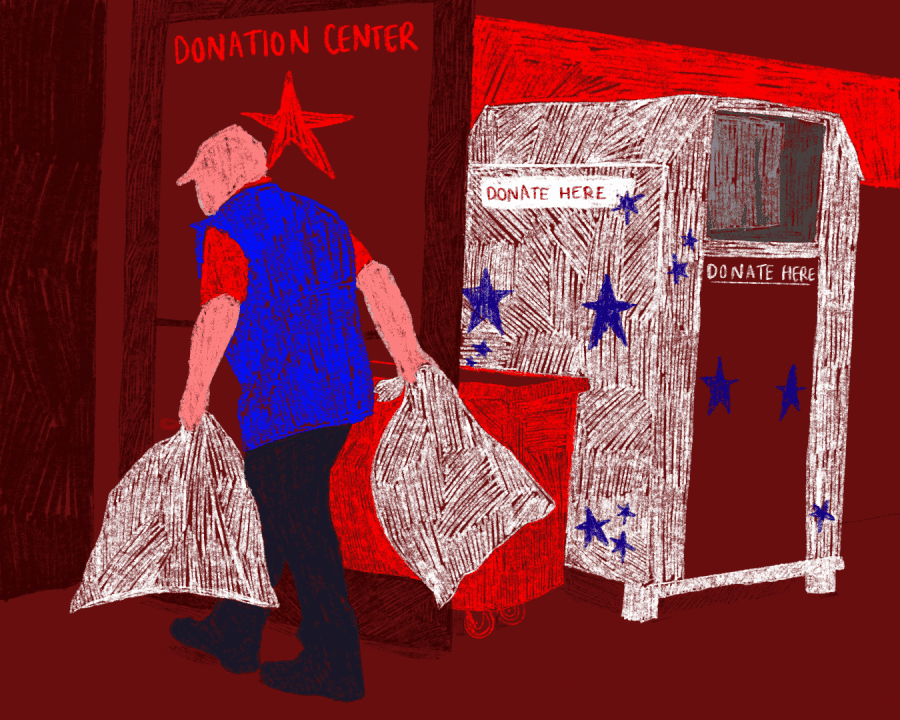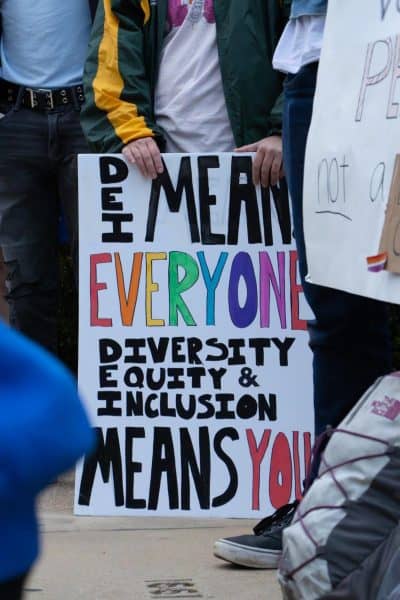Opinion | Earth can’t handle this much clothing
March 8, 2023
The world has a clothing problem. Every year, around 11.3 million tons of textile waste in the United States ends up being burned or dumped in landfills. In other words, 85% of unwanted outfits, unsold clothing and unused textiles go straight to the garbage.
The solution seems simple: instead of throwing our clothes into the trash, we should recycle or donate them, but the reality of these seemingly simple solutions is much more complex.
Only 2.5 million tons of clothing are recycled in the U.S., while 3 million are burned and 10 million are sent to landfills. Even if recycling was the perfect answer to a growing issue, it isn’t practiced enough to counteract the environmental damage of those 13 million tons. The 2.5 million tons that do get recycled are rarely used to create new clothing.
Generally, fibers must be mechanically recycled, which degrades their quality over time. Because of this, recycled clothing is usually downcycled to create items like insulation material and cleaning cloths. In 2016, H&M ran a campaign to collect unwanted clothing from their customers. While they collected 1,000 tons of recycled garments, environmental journalist Tatiana Schlossberg claims the effort is not as promising as it seems.
In “Inconspicious Consumption,” Schlossberg wrote that it could take H&M over a decade to use that much fabric. As one of fast fashion’s greatest contributors, what H&M could recycle in that time is equivalent to what they sell in just a few days.
H&M produces around half a billion garments annually, but less than 1% is created from recycled material. Though a recycling bin is preferable to a landfill, it doesn’t combat the core issue: the world simply can’t handle this much clothing.
The donation solution faces similar problems. Secondhand shopping is popular among Gen Z, and thrifting is ultimately a good choice for those looking to consume more responsibly. However, it’s important to be aware of its shortcomings.
The sheer volume of clothing in the world presents complications. Goodwill, for example, has managed to lengthen the lifespan of many garments. What they do is important, but even they have leftovers that end up in recycling centers or markets overseas.
Around 700,000 tons of secondhand clothing are exported from the U.S. yearly. Alyssa Hardy, author of “Worn Out: How Our Clothes Cover Up Fashion’s Sins,” reports that 15 million used garments are imported into Ghana alone on a weekly basis. With so much clothing coming into the country, items may sit in a factory for years before entering secondhand markets.
In other cases, the imports may be too worn out to be sold, ending up in the landfill anyways. The waste still exists, it just is placed on the shoulders of developing countries. The donation solution is a myth which effectively distracts consumers from the environmental costs of their purchases.
The rise of fast fashion only adds to the complexity of the clothing issue. The pace of social media’s ever-shifting trends can only be met by fast fashion brands. The hashtag #Shein, for a popular fast-fashion brand, has accumulated over 51.4 billion views on TikTok, which is undoubtedly one of the biggest influences on Gen Z’s fashion choices. For college students in particular, the combination of low prices and relevant options makes fast fashion appealing. There’s a hidden price that can’t be ignored, however.
The average consumer is buying 60% more clothing than they did in 2005. Brands such as Shein, who introduced 1.5 million unique styles in 2021 alone, encourage this rise in consumption. On top of this, fast fashion garments are typically poor quality as the focus is on speed and cheapness.
Garments are now worn around seven to 10 times on average before being thrown out; that’s a 35% decrease from 15 years ago. The burden of clothing on the planet is growing at a rate we’re unable to keep up with.
Individually, the best thing we can do is try to shop ethically, but that’s easier said than done. A severe lack of transparency from brands keeps buyers in the dark. Brands may also mislead concerned customers through a marketing tactic known as greenwashing.
Zara does not use plastic bags in their stores, and has pledged to use only 100% sustainable fabrics by 2025. H&M’s website has a page dedicated to sustainability. On this page is a link to a list of achievements and a note saying, “Back in 2013, we became the first global fashion retailer to launch a garment collecting program in all our stores.”
Although these efforts are positive, they should not absolve brands from criticism regarding their contributions to clothing waste. H&M reported $4.3 billion in unsold inventory back in 2018. The fast-fashion business model is inherently wasteful, and no amount of small ethical practices can make up for it.
Secrecy and greenwashing are designed to keep buyers complacent. As consumers, we’ve become stuck in an endless cycle of wanting more and knowing exactly where we can get it. Brands are using social media to reach a young generation that desperately wants to stay on trend.
Even once we’re aware of fast fashion’s problems, it’s still easy to excuse our shopping habits. Sustainable clothing from ethical brands is often expensive. Sites like Shein make trendy clothing more accessible to those who can’t afford the alternative and individual efforts can feel futile when Shein sales amounted to $16 billion in 2021.
There is truth in these defenses, but staying complacent is not the answer to such a complex issue. With dubious adherence to labor laws, poor working conditions, and complete disregard for the environment, fast fashion throws ethics out the window for profits’ sake. We don’t need to be perfect consumers to recognize this.
The greatest responsibility lies on brands to be transparent and act ethically. Unfortunately, the fast fashion industry will remain unsustainable and exploitative as long as it is profitable. Our role as the consumer is to demand better. If we continue to feed into fast fashion, companies will have no incentive to be better.
If we can’t shop 100% ethically, we should at least shop responsibly. Buying a top from Shein is one thing; making a $200 Shein purchase is another. Instead of putting our money towards a higher quantity, we should put it towards higher quality items when possible. In doing so, we buy less and our clothes last longer. When we’re itching for something new and affordable, secondhand stores provide a better alternative.
We don’t have to stop buying clothes that we like, but we need to consider the impact of our purchases. Before buying a new outfit, remember that it can’t just be recycled or donated out of existence.











